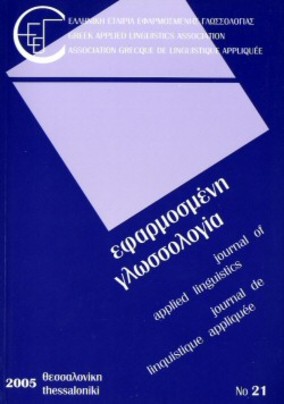Αντιλήψεις των διδασκόμενων την νέα ελληνική ως δεύτερη/ξένη γλώσσα αναφορικά με τη διδασκαλία του μεταφορικού τρόπου έκφρασης
Part of : Εφαρμοσμένη γλωσσολογία ; No.28, 2013, pages 13-27
Issue:
Pages:
13-27
Author:
Abstract:
This paper reports a study on Modern Greek learners’ notions of metaphors and idioms. Both metaphors and idioms are pervasive in everyday language and are deemed to be indicators of second language proficiency. Keeping in mind that Modern Greek is full of figurative language in everyday use, we conducted a large-scale survey in order to investigate intermediate and advanced Modern Greek learners ’ beliefs regarding the necessity of teaching metaphors and idioms and incorporating them into the syllabus. Our findings are in line with previous experimental data and indicate that our study participants developed positive attitudes towards metaphors and metaphorically motivated idiomatic phrases, due to their facilitative role in everyday communication with native speakers and in overall communicative competence.
Subject (LC):
Notes:
Περιέχει πίνακα, παράρτημα και βιβλιογραφία
References (1):
- Αναστασιάδη-Συμεωνίδη, Α. (2006). Πρόταση για τη διδασκαλία της μεταφοράς. Μελέτες για την Ελληνική Γλώσσα, 26: 45-56. Αναστασιάδη-Συμεωνίδη,Α. και Α. Ευθυμίου (2006). Οι στερεότυπες εκφράσεις και η διδακτική της νέας ελληνικής ως δεύτερης γλώσσας. Αθήνα: Πατάκης.Boers,F. (1999). Learning vocabulary through metaphor awareness. Etudes et Travaux,3:53-65.Boers,F.(2001). Remembering figurative idioms by hypothesising about their origin.Prospect,16/3:35-43.Boers,F.(2004). Expanding learners’ vocabulary through metaphoric awareness: What expansion, what learners, what vocabulary? In M. Achard and S. Niemeier (eds),CognitiveLinguistics,Second LanguageAcquisition,andForeignLanguage Teaching.Berlin & New York: Mouton de Gruyter, 211-232 Γαλαντόμος, I. (2008). Η διδασκαλία των μεταφορών και των ιδιωτισμών της νέας ελληνικής ως ξένης/δεύτερης γλώσσας. Αδημοσίευτη Διδακτορική Διατριβή. Παιδαγωγικό Τμήμα Ειδικής Αγωγής. Βόλος: Πανεπιστήμιο Θεσσαλίας.Cooper, Th.C. (1999). Processing of idioms by L2 learners of English. TESOL Quarterly,33: 233-262.Danesi, M. (1992). Metaphorical competence in second language acquisition and second language teaching: The neglected dimension. In J.E. Alatis (ed.), Language, Communication and Social Meaning. Washington, DC: Georgetown University Press, 489-500.Danesi, M. (1995). Learning and teaching languages: The role of “conceptual fluency ”.International Journal of Applied Linguistics, 5: 3-20.Danesi, M. and D’ Alfonso, A. (1989). Creativity in the second language classroom: Towards a “Vichian ” approach to second language teaching. Italica, 66: 9-19.Gibbs, R. and J.E. O’ Brien (1990). Idioms and mental imagery: The metaphorical motivation for idiomatic meaning. Cognition, 36: 35-68.Granger, S. (1998). Prefabricated patterns in advanced EFL writing. Collocations andformulae. In A.P. Cowie (ed.), Phraseology: Theory, Analysis and Applications. Oxford:Oxford University Press, 145-160.Kövecses, Z. (2005). Metaphor in Culture. Universality and Variation. Cambridge: Cambridge University Press.Lakoff, G. (1987). Women, Fire, and Dangerous Things: What Categories Reveal about theMind. Chicago and London: The University of Chicago Press.Läufer, B. (1997). What ’s in a word that makes it hard or easy: Some intralexical factorsthat affect the learning of words. In N. Schmitt and M. McCarthy (eds), Vocabulary: Description, Acquisition and Pedagogy. Cambridge: Cambridge University Press, 140-155.Liontas, J. (2002). Exploring second language learners’ notions of idiomaticity. System,30: 289-313.Littlemore, J. (2004). What kind of training is required to help language students usemetaphor-based strategies to work out the meaning of new vocabulary? D.E.L. T.A.,20:265-279.Marton, W. (1977). Foreign vocabulary learning as problem number one of foreign language teaching at the advanced level. Interlanguage Studies Bulletin, 2/1: 33-47.Meara, P. (1980). Vocabulary acquisition: A neglected aspect of language learning. Language Teaching and Linguistics: Abstracts, 13: 221-246.Meara, P. (2002). The rediscovery of vocabulary. Second Language Research, 18: 393-407.Μήτσης, N. (2004). Η διδασκαλία της γλώσσας υπό το πρίσμα της επικοινωνιακής προσέγγισης: Εισαγωγή στη θεωρία και τις τεχνικές του επικοινωνιακού μοντέλου. Αθήνα: Gutenberg.Piquer Pi'riz, A.M. (2008). Reasoning figuratively in early EFL: Some implications forthedevelopment of vocabulary. In F. Boers and S. Lindstromberg (eds), CognitiveLinguistic Approaches to Teaching Vocabulary and Phraseology. Berlin and New York:Mouton de Gruyter, 219-240. Ρουσσος, ΙΙ.Λ. και Γ. Τσαοιίσης (2002). Στατιστική εφαρμοσμένη στις κοινωνικές επιστήμες. Αθήνα: Ελληνικά Γράμματα.Thornbury, S. (2002). How to Teach Vocabulary. Harlow, UK: Longman.Τριάρχη-Herrmann, B. (2000). Η διγλωσσία στην παιδική ηλικία: Μια ψυχογλωσσολογική προσέγγιση. Αθήνα: Gutenberg.Wilkins, D.A. (1972). Linguistics in Language Teaching. London: Edward Arnold.Yorio, C.A. (1989). Idiomaticity as an indicator of second language proficiency. In K.Hyltenstam and L.K. Obier (eds), Bilingualism across the LifespanAspects of Acquisition, Maturity, and Loss. Cambridge: Cambridge University Press, 55-72.




